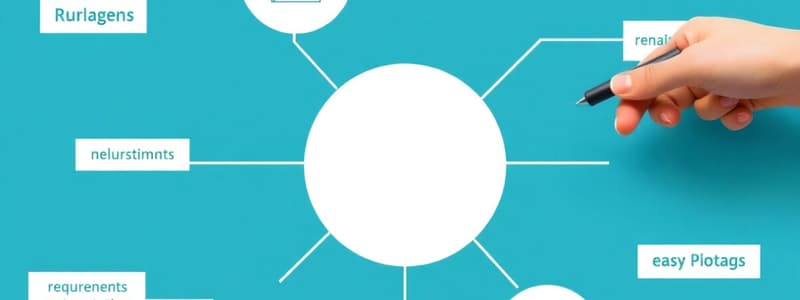Podcast
Questions and Answers
What does Solution Evaluation involve?
What does Solution Evaluation involve?
- Designing organizational structures
- Creating business requirements
- Eliciting stakeholder feedback
- Validating and verifying information (correct)
Which of the following is NOT a perspective included in the BABOK guide?
Which of the following is NOT a perspective included in the BABOK guide?
- Business Architecture
- Data Analytics
- Agile
- Underlying Competencies (correct)
What term describes a problem or opportunity that needs to be addressed?
What term describes a problem or opportunity that needs to be addressed?
- Change
- Stakeholder
- Need (correct)
- Solution
What action corresponds to the definition of Change?
What action corresponds to the definition of Change?
Which term identifies individuals or groups connected to a change, need, or solution?
Which term identifies individuals or groups connected to a change, need, or solution?
What does the term Solution refer to in the context of business analysis?
What does the term Solution refer to in the context of business analysis?
What does Context refer to in business analysis?
What does Context refer to in business analysis?
Which term describes the worth or usefulness of something to a stakeholder in a given situation?
Which term describes the worth or usefulness of something to a stakeholder in a given situation?
What is the purpose of assessing requirement changes?
What is the purpose of assessing requirement changes?
Which process involves ranking requirements based on their importance to stakeholders?
Which process involves ranking requirements based on their importance to stakeholders?
What best describes the relationship where one requirement is derived from another?
What best describes the relationship where one requirement is derived from another?
What is used to identify where, what, why, when, how, and for whom information is exchanged in a solution?
What is used to identify where, what, why, when, how, and for whom information is exchanged in a solution?
What is the purpose of maintaining requirements traceability?
What is the purpose of maintaining requirements traceability?
Which framework is used to manage performance across different business models?
Which framework is used to manage performance across different business models?
Which activity involves working with stakeholders to approve and agree on requirements?
Which activity involves working with stakeholders to approve and agree on requirements?
What provides a shared understanding of outcomes and aligns with strategy in a business context?
What provides a shared understanding of outcomes and aligns with strategy in a business context?
What is involved in prioritizing requirements?
What is involved in prioritizing requirements?
What type of relationship indicates that a requirement depends on another requirement?
What type of relationship indicates that a requirement depends on another requirement?
What defines measures of value attributes for assessing solutions?
What defines measures of value attributes for assessing solutions?
What is the role of documenting requirements according to business analysis approaches?
What is the role of documenting requirements according to business analysis approaches?
Which option provides justification for a proposed solution based on benefits versus costs?
Which option provides justification for a proposed solution based on benefits versus costs?
What shows how repeatable business decisions are made?
What shows how repeatable business decisions are made?
Which approach is conducted to improve organizational operations and increase value to stakeholders?
Which approach is conducted to improve organizational operations and increase value to stakeholders?
What is used to organize business vocabulary for effective communication within a domain?
What is used to organize business vocabulary for effective communication within a domain?
Which method is primarily used to elicit information through observation of activities and their context?
Which method is primarily used to elicit information through observation of activities and their context?
What is the primary purpose of prioritization in business analysis?
What is the primary purpose of prioritization in business analysis?
Which term describes the systematic approach for managing and prioritizing remaining work?
Which term describes the systematic approach for managing and prioritizing remaining work?
What technique is intended to generate new ideas and themes for further analysis?
What technique is intended to generate new ideas and themes for further analysis?
Which method is used to validate stakeholder needs through iterative modeling?
Which method is used to validate stakeholder needs through iterative modeling?
What interactive group activity helps elicit ideas and opinions from participants regarding a product or service?
What interactive group activity helps elicit ideas and opinions from participants regarding a product or service?
Which collaborative technique encourages participants to work together to build an understanding of a solution?
Which collaborative technique encourages participants to work together to build an understanding of a solution?
What systematic approach is used to gather information through dialogue in interviews?
What systematic approach is used to gather information through dialogue in interviews?
What is the focus of predictive approaches in business analysis?
What is the focus of predictive approaches in business analysis?
Which approach focuses on delivering business value in short iterations despite requiring acceptance of higher uncertainty?
Which approach focuses on delivering business value in short iterations despite requiring acceptance of higher uncertainty?
Which component provides a description of activities performed by a business analyst?
Which component provides a description of activities performed by a business analyst?
What includes results of assessments to be incorporated into planning approaches?
What includes results of assessments to be incorporated into planning approaches?
What defines the boundaries within which decisions must be made in business analysis?
What defines the boundaries within which decisions must be made in business analysis?
Which method is used to determine the optimal business analysis approach?
Which method is used to determine the optimal business analysis approach?
Which component shapes the business analysis approach by providing methods and techniques?
Which component shapes the business analysis approach by providing methods and techniques?
What is the purpose of a stakeholder engagement approach in business analysis?
What is the purpose of a stakeholder engagement approach in business analysis?
What is the primary focus of defining the components of business analysis that support governance functions?
What is the primary focus of defining the components of business analysis that support governance functions?
Which activity involves understanding stakeholder needs and collaboration with them?
Which activity involves understanding stakeholder needs and collaboration with them?
When managing and monitoring business analysis work, what is the key focus?
When managing and monitoring business analysis work, what is the key focus?
What does the planning of business analysis work primarily involve?
What does the planning of business analysis work primarily involve?
How is information developed by business analysts utilized for long-term purposes?
How is information developed by business analysts utilized for long-term purposes?
What is the main objective of identifying business analysis performance improvements?
What is the main objective of identifying business analysis performance improvements?
What is the first step in the plan business analysis approach process?
What is the first step in the plan business analysis approach process?
Which aspect is least associated with planning stakeholder engagement?
Which aspect is least associated with planning stakeholder engagement?
Flashcards
Solution Evaluation
Solution Evaluation
Assessing different solutions to a business problem, considering their advantages, disadvantages, and potential value.
Requirements Analysis and Design Definition
Requirements Analysis and Design Definition
Structuring, modeling, and validating requirements for a business solution.
Need
Need
A problem or opportunity that needs to be addressed.
Change
Change
Signup and view all the flashcards
Stakeholder
Stakeholder
Signup and view all the flashcards
Solution
Solution
Signup and view all the flashcards
Context
Context
Signup and view all the flashcards
Enterprise
Enterprise
Signup and view all the flashcards
Plan Business Analysis Approach
Plan Business Analysis Approach
Signup and view all the flashcards
Plan Stakeholder Engagement
Plan Stakeholder Engagement
Signup and view all the flashcards
Plan Business Analysis Governance
Plan Business Analysis Governance
Signup and view all the flashcards
Plan Business Analysis Information Management
Plan Business Analysis Information Management
Signup and view all the flashcards
Identify Business Analysis Performance Improvements
Identify Business Analysis Performance Improvements
Signup and view all the flashcards
Customer
Customer
Signup and view all the flashcards
Domain Subject Matter Expert (SME)
Domain Subject Matter Expert (SME)
Signup and view all the flashcards
Implementation SME
Implementation SME
Signup and view all the flashcards
Predictive business analysis approach
Predictive business analysis approach
Signup and view all the flashcards
Adaptive business analysis approach
Adaptive business analysis approach
Signup and view all the flashcards
Business analysis approach
Business analysis approach
Signup and view all the flashcards
Business Analysis Performance Assessment
Business Analysis Performance Assessment
Signup and view all the flashcards
Business Policies
Business Policies
Signup and view all the flashcards
Expert Judgment
Expert Judgment
Signup and view all the flashcards
Methodologies and Frameworks
Methodologies and Frameworks
Signup and view all the flashcards
Stakeholder Engagement Approach
Stakeholder Engagement Approach
Signup and view all the flashcards
Assess Requirements Changes
Assess Requirements Changes
Signup and view all the flashcards
Prioritize Requirements
Prioritize Requirements
Signup and view all the flashcards
Approve Requirements
Approve Requirements
Signup and view all the flashcards
Traceability
Traceability
Signup and view all the flashcards
Maintain Requirements
Maintain Requirements
Signup and view all the flashcards
Derive
Derive
Signup and view all the flashcards
Depends
Depends
Signup and view all the flashcards
Satisfy
Satisfy
Signup and view all the flashcards
Observation
Observation
Signup and view all the flashcards
Prioritization
Prioritization
Signup and view all the flashcards
Backlog Management
Backlog Management
Signup and view all the flashcards
Brainstorming
Brainstorming
Signup and view all the flashcards
Prototyping
Prototyping
Signup and view all the flashcards
Focus Groups
Focus Groups
Signup and view all the flashcards
Collaborative Games
Collaborative Games
Signup and view all the flashcards
Interviews
Interviews
Signup and view all the flashcards
Interface Analysis
Interface Analysis
Signup and view all the flashcards
Balanced Scorecard
Balanced Scorecard
Signup and view all the flashcards
Business Capability Analysis
Business Capability Analysis
Signup and view all the flashcards
Acceptance and Evaluation Criteria
Acceptance and Evaluation Criteria
Signup and view all the flashcards
Business Cases
Business Cases
Signup and view all the flashcards
Decision Modelling
Decision Modelling
Signup and view all the flashcards
Benchmarking and Market Analysis
Benchmarking and Market Analysis
Signup and view all the flashcards
Concept Modelling
Concept Modelling
Signup and view all the flashcards
Study Notes
Business Analysis Techniques
- Business Analysis Planning and Monitoring: Organizing and coordinating the efforts of business analysts and stakeholders.
- Elicitation and Collaboration: Preparing for and conducting elicitation activities, confirming results.
- Requirements Life Cycle Management: Managing and maintaining requirements and design information from inception to retirement.
- Strategy Analysis: Identifying strategic or tactical business needs, aligning with higher- and lower-level strategies, and collaborating with stakeholders.
- Requirements Analysis and Design Definition: Structuring and organizing requirements, modeling and validating design, identifying solution options.
- Solution Evaluation: Assessing solution performance and value, recommending barrier removal.
Business Analysis Concepts
- Change: A problem or opportunity to be addressed.
- Need: The problem or opportunity requiring resolution.
- Solution: A specific way to satisfy one or more needs within a defined context.
- Stakeholder: An individual or group with a relationship to the change, need, or solution.
- Value: The worth, importance, or usefulness of something for a stakeholder within a specific context.
- Context: The circumstances that influence, are influenced by, and provide understanding of the change.
- Enterprise: A system of one or more organizations and the solutions they use to pursue mutual goals.
- Plan: A proposal for doing or achieving something.
- Business Requirements: Needs of stakeholders for achieving the business objectives.
- Stakeholder Requirements: Needs of stakeholders needed to achieve business requirements.
- Solution Requirements: Capabilities and qualities of a solution to meet stakeholder requirements.
- Transition Requirements: The capabilities and conditions required for a solution to transition from a current to a future state.
- Business Analysis Performance Improvements: The process of managing and monitoring how business analyst work is performed to ensure that commitments are met and continuous learning and improvement opportunities are realized.
Business Analysis Techniques (Specifics)
- Elicitation: The process of understanding stakeholder needs, discovering requirements, validating and verifying information, identifying solution options.
- Elicitation Activity Plan: Information used for each elicitation activity that includes logistics, activity scope, techniques and materials.
- Elicitation Results: The captured information from elicitation activity.
- Planning the Business Analysis Approach: Defining the methodological components used in business analysis, stakeholder engagement and governance.
- Plan Stakeholder Engagement: Establishing and maintaining effective working relationships with stakeholders.
- Plan Business Analysis Governance: Defining how decisions are made, including reviews and change control for requirements and designs.
- Plan Business Analysis Information Management: Managing the capture, storage and use of information.
Other Concepts and Processes
- Preventive: Reducing the probability or impact of negative events.
- Corrective: Reducing/repairing the negative impact of an event after it has already occurred.
- Improvement: Increasing the probability or impact of positive events.
- Measure Solution Performance: Evaluates solution performance in relation to current business needs and value it brings.
- Analyze Performance Measures: Determines and analyzes the cause of any performance issues identified during evaluation or measurement.
- Assess Solution Limitations: Identifies the issues or bottlenecks that prevent a solution from fully delivering its intended value.
- Assess Enterprise Limitations: Identifies issues outside the solution scope that may prevent an effective change.
- Recommend Actions to Increase Solution Value: Identifying and recommending the steps needed to optimize the value of a solution.
- Requirements Traceability: Tracking and managing the relationships between different types of requirements and designs throughout the analysis process.
- Prioritization: Determining the relative importance of requirements, based on factors like stakeholder needs and risks.
- Requirement Validation: Checking the requirements against the actual business need, ensuring consistency, and providing high quality output.
- Business Analysis Approach: A combination of models, practices, methods and technique used by an enterprise for business analysis.
- Requirements Maturity: Attributes that describe the stability of a requirement.
- Quality Control of Requirements / Designs: Processes and techniques for verifying the quality of requirements.
- Elicitation Techniques: Various methods for collecting information from stakeholders (interviews, workshops, questionnaires).
- Stakeholder Concerns: Addressing concerns and interests expressed by affected parties to influence the business analysis approach.
- Solution Components: The individual pieces used to assemble the solution.
Studying That Suits You
Use AI to generate personalized quizzes and flashcards to suit your learning preferences.




